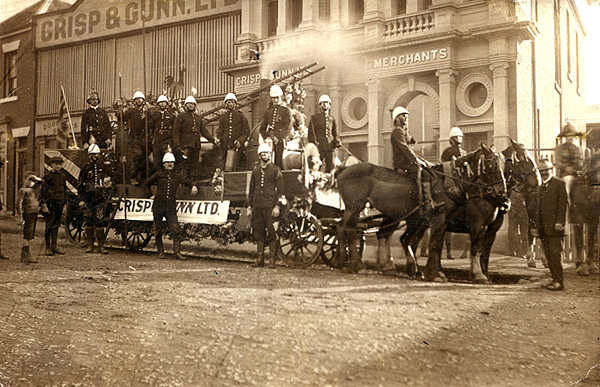 |
 |
|
Fire brigades
Fire brigades in Tasmania had humble beginnings in the need of the community to protect itself from the havoc wreaked by fire. When the call of 'Fire' was heard in the growing towns, all available members of the community would race to the scene; the pending disaster would be like a magnet drawing men, women and children to witness the devastation. Eager hands would soon be at work either forming a 'bucket line' in an attempt to suppress the fire, or to clear the building of its contents, often doing more damage to the chattels as they were hastily thrown from the building, than actually extinguishing the fire. Early firefighting was badly managed with little or no equipment and either the military or local constable taking control. More often than not the building concerned was either badly damaged or totally destroyed as local residents went about the disorganised task of firefighting with considerable misplaced enthusiasm. With the increase in commerce and the spread of towns, rudimentary brigades were formed by a few residents who banded together to protect their town, often receiving no remuneration for their services; the only reward was the admiration and respect of the community. To encourage participation, some brigades became Friendly Societies, offering members social interaction as well as sickness and death benefits. This was particularly noticeable in Launceston during the 1860s and 1870s, when the two main volunteer brigades offered these benefits to all their members and held regular social events. In the late 1880s insurance companies played a greater part in the formation of fire brigades. It was in the interests of the insurance companies to encourage the formation of brigades – primitive through they were – as property lost from fire reduced their profits. The spread of population, growth of towns and increased pressure to form fire brigades led to the Fire Brigades Act (1920), which proclaimed Fire Districts and the formation of boards to control individual fire brigades. Often boards looked after volunteer firemen and the system worked well, but there was disenchantment with some who were more interested in their own positions than actual firefighting or town protection. This led in 1939 to a major conference of boards and ultimately to the formation, in 1946, of the Fire Brigades Commission of Tasmania to oversee the operation of firefighting and the boards. It was replaced in 1977 by the state Fire Authority, and two years later by the Tasmania Fire Service. Full-time professional brigades are situated at Hobart (formed 1883), Launceston (amalgamation 1884), Devonport (1896) and Burnie (1896), and there are 22 urban volunteer fire brigades. The first was Longford, formed in 1862; others were Latrobe 1878, Zeehan 1891; Queenstown, Gormanston/Linda, Ulverstone and Wynyard 1901–14; Scottsdale, Deloraine, Oatlands 1920–25; Franklin, Sheffield/Railton, Cygnet, Huonville, New Norfolk 1934–39; Geeveston, Kingston, Fern Tree 1942–46; Somerset, Cressy, Currie, Stanley, Beaconsfield, George Town 1951–57; Gravelly Beach, Campbell Town, Midway Point, Perth and St Helens 1961–83. Some formed in early years have closed. Country towns are serviced by either the urban brigades or the Country Fire Service wing of the Tasmania Fire Service. Further reading: R McNeice, Helmets and hatchets, Hobart, 1983; Men of fire, Hobart, 1987; The New Norfolk volunteer urban fire brigade, Hobart, 1989; With skill and dedication, Hobart, 1993; and Knapsack heroes, Hobart, 1991. Roger McNeice |
Copyright 2006, Centre for Tasmanian Historical Studies |
